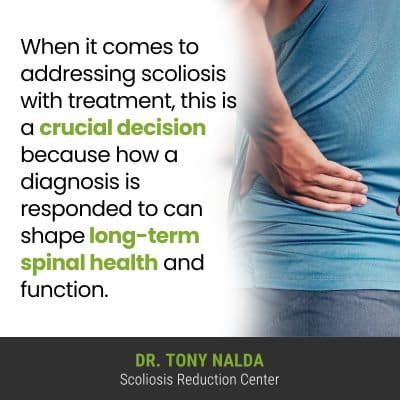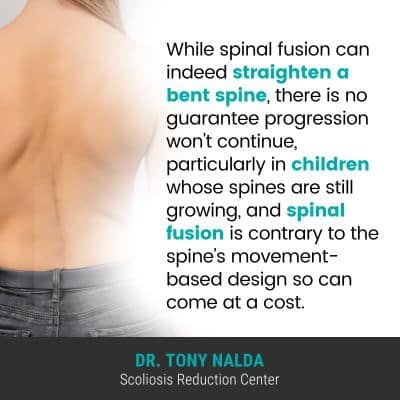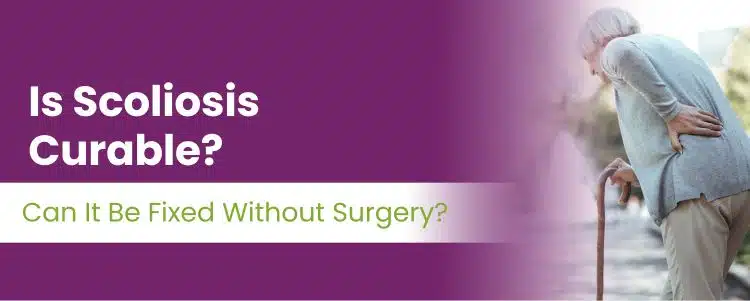Scoliosis is a progressive condition, meaning its nature is to get worse over time; only a small percentage of people with scoliosis won’t experience progression. Proactive treatment is needed to work towards counteracting the condition’s progressive nature and increasing effects.
Scoliosis is an incurable progressive condition, but it can be highly treatable. A diagnosis of scoliosis doesn’t have to mean a life of limitations; there are no guarantees, but with an early diagnosis and early intervention, there are fewer limits to what nonsurgical treatment can achieve.
Scoliosis is a complex structural spinal condition, so let’s start with how it’s diagnosed.
Diagnosing Scoliosis
Diagnosing scoliosis means an unnatural side to side curve has developed that bends to the side and also rotates, making scoliosis a 3-dimensional condition.
Scoliosis is diagnosed through a physical examination that involves taking the patient’s family and medical history, performing an Adam’s test where patients bend forward to have their spines and trunks examined, and the results of a scoliosis X-ray.
The spine’s natural and healthy curves make it stronger, more flexible, and better able to absorb and distribute mechanical stress through movement, so what happens if an unnatural spinal curve develops?
If the spine loses one or more of its healthy curves, they are replaced by bad curves, and unhealthy spinal curves introduce a lot of uneven pressure and forces to the spine, its surrounding muscles, nerves, and the entire body.
Diagnosing scoliosis also involves further classifying conditions based on key patient/condition variables such as patient age, condition type, severity, and curvature location, and this helps streamline the treatment process along with informing the crafting of effective treatment plans.
The most important decision patients have to make is how to address their conditions with treatment.
Scoliosis Treatment Options

When it comes to addressing scoliosis with treatment, this is a crucial decision because how a diagnosis is responded to can shape long-term spinal health and function.
Scoliosis patients need to be aware that there is more than just a surgical response to scoliosis, and there was a time when surgical treatment was the main choice and many patients were unknowingly funneled in that direction.
The truth is that many cases of scoliosis don’t require surgery, and the success of conservative scoliosis treatment has proven results.
There are two main scoliosis treatment approaches for patients to choose between, and I can’t understate how important it is for patients to ensure they fully understand the pros and cons of each.
Traditional scoliosis treatment was the dominant choice for many years, but that didn’t make it the best, nor only treatment option available.
Traditional Scoliosis Treatment and Spinal Fusion Surgery
As a progressive condition, again, scoliosis can’t be cured in the sense of reaching a permanent cure; scoliosis treatment is more about effectively managing an ongoing condition.
Scoliosis progression is triggered by growth, so a growth spurt as a child grows can cause the scoliotic curve size to increase; the age group most at risk for rapid-phase progression are adolescents, and adolescent idiopathic scoliosis is the most prevalent type of scoliosis overall.
A surgical response to scoliosis has the goal of stopping progression, not correcting the condition: an important distinction we’ll return to later.
So what is scoliosis surgery? Spinal fusion surgery is a surgical response to scoliosis that involves fusing the curve’s most-tilted vertebrae into one solid bone, and then metal rods are commonly attached to the spine with pedicle screws to hold it in place, and this is permanent.
The process often involves the removal of intervertebral discs that sit between adjacent vertebral bodies to be fused.
While spinal fusion can indeed straighten a bent spine, there is no guarantee progression won’t continue, particularly in children whose spines are still growing, and spinal fusion is contrary to the spine’s movement-based design so can come at a cost.
Many patients are disappointed with the loss in spinal flexibility and range of motion they are left with, while others suffer from increased back pain at the fusion site.
Every scoliosis patient will respond to spinal fusion differently; some important factors are patient age and overall health, condition type, severity, and the number of vertebrae fused.
Shorter fused segments are less invasive than larger ones, and while some patients maintain enough spinal flexibility above and below the fused portion, others notice enough of a loss in spinal flexibility to impact their overall quality of life.
In addition, a fused spine is going to be weaker and more vulnerable to injury, and this knowledge can have a psychological effect.
How Can Scoliosis Be Treated Without Surgery?

So while no form of treatment can cure scoliosis, conservative treatment has the goal of achieving corrective results, which is different from the surgical goal of stopping progression.
Conservative scoliosis treatment gives patients a less-invasive and costly alternative to spinal fusion, and conservative treatment manages curve progression by, first and foremost, working towards impacting the condition’s underlying structural nature, and this involves a curvature reduction.
Chiropractic Care
Achieving corrective treatment results means that the structure of the spine has been altered, and this involves condition-specific chiropractic care working towards manually adjusting the position of the curve’s most-tilted vertebrae: a more natural approach than using hardware to hold the spine in a corrective position.
Once I see structural results, I can shift the focus to increasing core strength, achieved through a combination of scoliosis-specific exercises and physical therapy, so the spine is optimally supported by its surrounding muscles.
Physical Therapy
Strong core muscles also help with improving posture, and certain scoliosis-specific exercises can help improve brain-body communication by activating specific areas of the brain.
Physical therapy can address muscle weakness and/or a muscular imbalance; an unnaturally-curved spine can pull its surrounding muscles in different directions, causing pain and muscles on one side of the spine to become weak from underuse, while muscles on the other side can become sore and stretched from overuse.
Addressing a muscular imbalance is important for stabilizing the spine, and as scoliosis progresses, the body’s center of gravity will shift, causing issues with balance, coordination, and changes to gait.
Corrective Bracing
Corrective bracing can help by pushing the spine into a corrective position, and when combined with other facets of scoliosis treatment, braces like the ScoliBrace are known to be particularly effective on growing spines.
Traditional scoliosis bracing is associated with a number of shortfalls that the modern ScoliBrace addresses, including pushing the spine, instead of squeezing it excessively.
Rehabilitation
As an ongoing condition, rehabilitation can also be an ongoing process; this can involve guidance on how to lead a spine- and scoliosis-friendly lifestyle, continued chiropractic care, and the prescription of scoliosis-specific exercises that can be easily performed from home.
A home-rehabilitation program can help further heal and stabilize the spine for sustainable long-term treatment results.
Conclusion
While scoliosis is incurable, and that is understandably difficult for those recently diagnosed with scoliosis to hear, the condition can be highly treatable.
I also always like to point out, particularly to my adolescent patients, that a scoliosis diagnosis doesn’t have to mean a life of limitations, nor does it have to mean giving up on one’s dreams; the number of successful professional athletes and celebrities with scoliosis can be motivating and inspiring for others recently diagnosed.
Mild scoliosis will only stay mild if it’s treated proactively, and when successful, treatment options can help reduce pain, curvature size, increase core strength and manage progression, and not all scoliosis treatment has to involve invasive spinal surgery.
Treatment for scoliosis patients can involve spinal fusion that uses metal rods and screws to keep the spine straight, but the way this is achieved can cost the spine in terms of its long-term spinal strength and function, and this can affect a patient’s overall quality of life.
When conservative treatment is applied early in a condition’s progressive line and is designed by an experienced team of scoliosis specialists, there are fewer limits to what can be achieved.
Through condition-specific chiropractic care, physical therapy, corrective bracing, and rehabilitation, corrective results can be worked towards that are in line with the spine’s natural movement-based design, and regular checkups and rehabilitation can ensure treatment results are long-term and sustainable.
If scoliosis surgery is unsuccessful for any reason, or if hardware malfunctions in the future, the only recourse is more surgery, and the risks increase with age and each subsequent procedure.
Here at the Scoliosis Reduction Center®, I address scoliosis proactively by starting treatment as close to the time of diagnosis as possible; in most cases, it’s far more effective to proactively work towards preventing progression and increasing condition effects, than it is to attempt to reverse those effects once they’re established.




